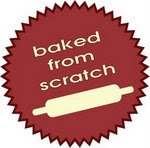 This started a couple of weeks ago with the making of my sourdough starter. To sourdough purists, there shouldn't be any packaged yeast in the dough. It should all be pulled into the flour naturally, so that's what I set out to do. I combined 1/4 c. white all-purpose flour with 1/4 c. filtered water, covered it with a tea towel, and let it sit for 24 hours. After that time passed, I added another 1/4 c. of each and mixed it up. Gradually, yeast is pulled out of the atmosphere and into the sourdough starter. Every time you add flour and water, you're giving the yeast some more food to eat and multiply.
This started a couple of weeks ago with the making of my sourdough starter. To sourdough purists, there shouldn't be any packaged yeast in the dough. It should all be pulled into the flour naturally, so that's what I set out to do. I combined 1/4 c. white all-purpose flour with 1/4 c. filtered water, covered it with a tea towel, and let it sit for 24 hours. After that time passed, I added another 1/4 c. of each and mixed it up. Gradually, yeast is pulled out of the atmosphere and into the sourdough starter. Every time you add flour and water, you're giving the yeast some more food to eat and multiply.You essentially keep feeding the starter water and flour until you're ready to bake with it. If you feel that your starter is getting too big, you can easily take out as much as you're planning to add (i.e. you can mix up the starter, remove 1/2 c. of starter, replace with 1/4 c. flour and 1/4 c. water, that way you're still equal). Some people keep their starter around for years, and the older the sourdough starter the more developed the flavor becomes. When your starter finally becomes nice and bubbly (should take anywhere from 4 days to a week), you can cover it and store it in the fridge, then you only have to feed it once a week instead of daily.
 You can tell it's ready when it gets a nice froth on top and turns bubbly. Don't worry too much about bacteria - a byproduct of yeast is ethanol, the same reason why beer and wine have alcohol in them. This ethanol is a natural defense mechanism, since most bacteria can't live in alcoholic conditions, and that can be used to our advantage to make sure that the starter remains bacteria-free. However, isn't a guarantee though. Always play it safe - if you start getting any pink or green colorings, immediately throw it away and start over.
You can tell it's ready when it gets a nice froth on top and turns bubbly. Don't worry too much about bacteria - a byproduct of yeast is ethanol, the same reason why beer and wine have alcohol in them. This ethanol is a natural defense mechanism, since most bacteria can't live in alcoholic conditions, and that can be used to our advantage to make sure that the starter remains bacteria-free. However, isn't a guarantee though. Always play it safe - if you start getting any pink or green colorings, immediately throw it away and start over.Don't forget that this starter is your new pet. Sure it doesn't have to be taken for walks or cleaned, but it does need to be fed. You'd be sad if you went to make sourdough and found your colony of yeast had died off because you forgot to give them dinner.
After raising the little guys for a couple weeks, I decided it was time to sacrifice some of them and make some dough.
Recipe:
2 c. sourdough starter
2 t. salt
1/2 t. sugar
2 T. olive oil
3 c. flour
In a mixer with hook attachment, pour in the starter, salt, sugar, olive oil, and 1 c. flour. Mix until it just comes together, then add 1c. more flour. At this point, start to add the final cup of flour only a small amount at a time. Once the dough is no longer sticky and comes cleanly from the sides of the mixer, stop adding flour and knead the dough. This can be done by hand, but it's very convenient to use the mixer. I kneaded for about 10 minutes - sourdough takes a lot of kneading to make sure you get all the gluten into it. When your dough ball is kneaded to your content, place into a bowl with a small amount of olive oil and allow to rise from 6-12 hours. Sourdough takes longer than most breads to rise, so be patient.
Punch down the dough and spread into a rough rectangle with the dry side on top (the part that was exposed during the rising). Roll tightly to avoid air pockets, and form a loaf. Sprinkle some corn meal onto a baking pan and place your loaf on top, then spray with water and allow to proof for about 6 more hours, spraying with water periodically to keep the outside damp.
 Make deep slashes into the dough (about 1/3 of the way into the dough) along the top, spaced about an inch apart. Place into a cold oven and spray once more with the water, then turn the oven to 425ºF. Rotate the loaf 180º every 10 minutes and spray with more water. This steam adds to the nice crust. Mine baked for a total of 35 minutes, but it could take longer depending on the oven.
Make deep slashes into the dough (about 1/3 of the way into the dough) along the top, spaced about an inch apart. Place into a cold oven and spray once more with the water, then turn the oven to 425ºF. Rotate the loaf 180º every 10 minutes and spray with more water. This steam adds to the nice crust. Mine baked for a total of 35 minutes, but it could take longer depending on the oven. Allow to cool completely before cutting - the bread continues to cook even when you remove it from the oven, and if you cut in too early it could let out too much steam and ruin the interior. Once it's cooled, slice and enjoy. This came out pleasantly more sour than I was expecting. I assumed that with a young starter, I wouldn't be able to get the bite that I was hoping for, but I was happily surprised. This little loaf packs a lot of flavor, and I'm looking forward to the next week's lunches - without having to buy my own sourdough for once.
Allow to cool completely before cutting - the bread continues to cook even when you remove it from the oven, and if you cut in too early it could let out too much steam and ruin the interior. Once it's cooled, slice and enjoy. This came out pleasantly more sour than I was expecting. I assumed that with a young starter, I wouldn't be able to get the bite that I was hoping for, but I was happily surprised. This little loaf packs a lot of flavor, and I'm looking forward to the next week's lunches - without having to buy my own sourdough for once.


















































